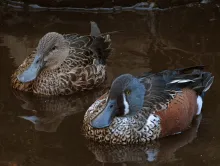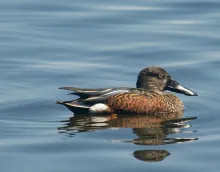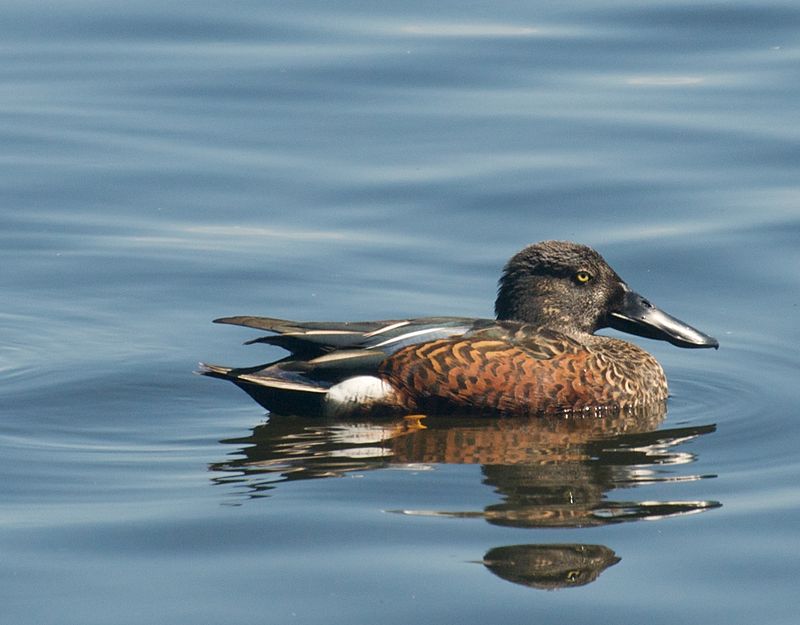
Australasian shoveler (Anas rhynchotis)
Species name
- Dutch name:
- Australische slobeend
- English name:
- Australasian shoveler
- German name:
- Australische Löffelente
- French name:
- Canard bridé
- Scientific name:
- Anas rhynchotis
Scientific classification
- Order:
- Anseriformes
- Family:
- Anatidae
- Onderfamilie:
- Anatinae
- Genus:
- Anas
Description
- Description:
The Australian Shoveler is a medium-sized, dabbling duck. In the beauty dress, the male has a blue-gray head. The head feathers shines weakly. Remarkable is an oblong, white line running downwards from the front eyelid. It is particularly pronounced in the New Zealand subspecies. Its shape is variable, sometimes almost crescent-shaped. In the nominate form, it is occasionally hinted at. The vertex and throat are black-gray. The body bottom is gray. The feathers of the breast have different widths, bright seams, so that the breast looks scaly. This is particularly noticeable in the New Zealand subspecies, where in some years the seams are wide white. The same individuals have in some years, but also narrow bright cream-colored fringed breast feathers.
Male:
The Australian shoveler male's body sides are bright reddish brown to maroon. On the flanks there is a striking white spot. The back plumage is dark black-brown. The Schwanzunterdecke is a little lighter colored brown. In dormant or buoyant Australian shovelers, there are elongated feathers on the sides, some of which have white feather stems. In flight, the bright green wing mirror is conspicuous, which is bounded by a broad white band. The big, chunky beak is black-gray, the eyes are yellowish. Legs and feet are orange. In the resting gown the male of the nominate form resembles the female. However, the male is slightly reddish brown overall than the female. Even in the resting dress the eyes are yellowish. In the New Zealand subspecies, the back feathers in the serene gown of the male are black-green with narrow hems. The females of this subspecies have feathers with broad dark brown hems on the back.Female:
The female has a brown spotted plumage. Her eyes are brown and legs and feet are of a brownish orange. Also in her wing mirror is striking in flight. He is however overall brownish.
Standard Measurements
- Body Length (cm):
- The male (drake) of the Australasian shoveler measures approximately 46-53 centimeters. The female measures approximately 46-53 centimeters.
- Body Weight (grams):
- The male will weight about 665 gram. The female will weight about 665 gram.
The weight is notoriously variable and can only be used as indication!
- Subspecies:
There are two subspecies:
- S. rhynchotis rhynchotis - Australian shoveler, the nominate race, occurs in southwestern and southeastern Australia and Tasmania.
- S. rhynchotis variegata - New Zealand shoveler, occurs in New Zealand.
- Note:
Dabbling Ducks are generally hardy, easy to maintain and easy to breed. Shelter may be required by some of the smaller species in winter. They should be provided with cover (including marginal pond cover) and loafing areas as well as water. A pen which is 50% water is suggested. The water may be shallow (i.e. no more than two feet deep is required), and muddy areas for dabbling in are also appreciated. These ducks are generally good in mixed collections, although the smaller and quieter species may be bullied. Territorial disputes between ducks of the same species may be avoided by keeping only one pair of each species in an enclosure, unless the area is very large. For a single pair of ducks a pen are of 50 to 100 square metres, depending on the size of duck, should be provided.
Most species are ground nesters and both close ground cover and ground level nest boxes should be provided. Hand-rearing is generally preferred, as these ducks are generally poor parents in captive conditions, particularly in enclosures shared with other waterfowl. These ducks are prone to hybridization, particularly with closely related species, which should be kept apart from one another.
Australian shovelers should be provided with a good area (minimum 60 square metres, more prefered) of fairly shallow muddy water and good marginal pond cover. They may be fed as other waterfowl, with micro floating pellets, although a higher protein level (20-22%) than for most Anas species is suggested.
The ducklings are not particularly easy to breed and rear. Baby rice cereal and a sloppy preparation of starter crumbs in water has been suggested for the first few weeks, with some small seeds added in after this time. Added small-sized live food may be useful.
- Breeding:
- The female Australasian shoveler usually lays from 9-11 light blue green eggs and incubates them for 24-25 days.
- Artificial incubating:
The ideal relative humidity for incubating most waterfowl eggs is 55% (ground nesters) and 40% (cavity nesters). The temperature is usually 37.4°C. Set ventilation as recommended by the incubator manufacturer. Eggs must be turned, either automatically or by hand, a minimum of 4 times a day. As the duckling develops there is a loss of water from the egg and the air sac gets bigger. In normal development of an egg with a 24-25 days incubation, the air sac occupies about a third of it three days earlier. Cleanliness is vital and ideally eggs should be moved to a separate hatcher at this point, where the humidity should be increased to 65% and even higher once they have pipped internally.
- Bird banding:
- Recommended closed leg band ring size for the Australasian shoveler is 9 mm.The leg band ring can only be applied on a young dabbling duck at around 10-12 days old.
- It doesn't matter what leg that you band, but it's good to have a consistent system. Suggested: Left leg = Female, Right leg = Male
- Rearingfeed:
-
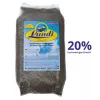
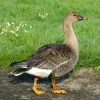

Floatable special rearing feed for all types of aquatic ornamental fowl - especially for the cultivation of trees as well as greening ducks.
This well-balanced complete feed with 20% protein content convinces above all by its good compatibility and forms the basis for visibly healthy growth from day one.
Made exclusively from wholesome and selected raw materials, Lundi Micro Regular is also ideally suited for the year-round feeding of waterfowl.
- Maintenance food:
-



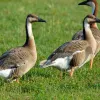

Lundi Regular with a protein content of 20%, valuable Spirulina and high-quality by-products is optimally balanced in its composition maintenance food for water ornamental fowl of all kinds. Especially green teal and Whistling ducks that are not dependent on a very high protein content, are well supplied.
Lundi Regular contains all the minerals and vitamins in full form that are important for the animals. Therefore also suitable as breeding food.


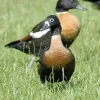


Floating full food for all sea ducks, green ducks, eider ducks and geese, especially in the moulting and breeding phase ideally suited. Packed with wholesome raw materials, natural vitamins and trace elements, this performance food with a protein content of 30% forms the basis for lifelong vitality.

